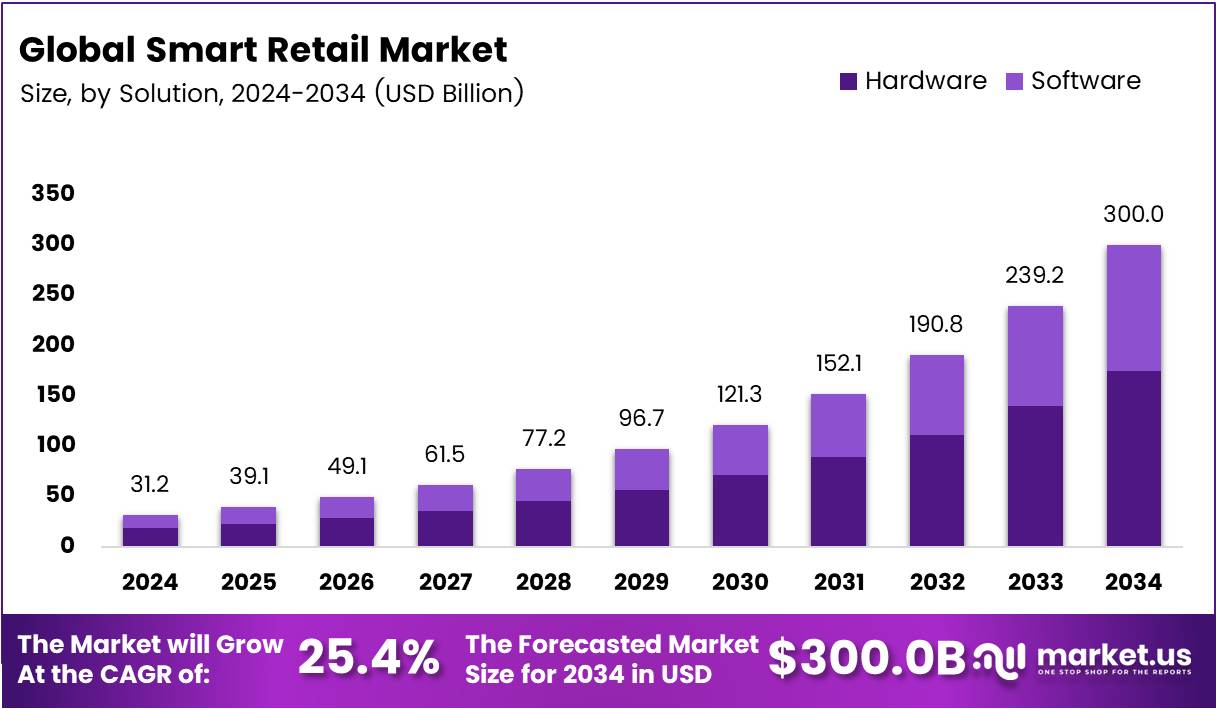Table of Contents
Introduction
The Global Smart Retail Market is undergoing a rapid transformation, blending advanced technologies with traditional retail models. Valued at USD 31.2 Billion in 2024, the market is projected to surge to USD 300.0 Billion by 2034, growing at a remarkable CAGR of 25.4%. This expansion is driven by evolving consumer preferences and the widespread adoption of digital retail solutions.
Smart retail combines artificial intelligence, IoT, data analytics, and automation to enhance customer experience and operational efficiency. As global retailers embrace technology-driven ecosystems, they’re unlocking new levels of personalization, convenience, and business agility. The shift toward omnichannel retailing has further amplified this growth.
Moreover, initiatives supporting digital transformation—ranging from smart city projects to government funding—are boosting retail modernization. With contactless payments, cloud-based inventory systems, and AI-powered analytics, the global smart retail industry is redefining how businesses engage with consumers and optimize performance.

Key Takeaways
- The Global Smart Retail Market will reach USD 300.0 Billion by 2034 from USD 31.2 Billion in 2024, registering a CAGR of 25.4%.
- The Hardware segment dominated the market in 2024 with a 58.4% share due to IoT devices and smart infrastructure integration.
- The Smart Payment System led the Application category with a 32.5% share, driven by digital wallets and contactless payment adoption.
- North America held a 36.2% market share in 2024, valued at USD 11.2 Billion, making it the leading regional market.
Market Segmentation Overview
By Solution: The Hardware segment dominates with a 58.4% share, propelled by the deployment of IoT devices, sensors, and interactive kiosks. These technologies form the backbone of smart retail systems, streamlining operations and supporting real-time analytics for enhanced decision-making.
By Application: Smart Payment Systems lead the market with a 32.5% share, fueled by the surge in mobile payments, contactless transactions, and digital wallets. This reflects growing consumer demand for convenience, speed, and secure payment experiences across all retail channels.
Drivers
1. Increasing Adoption of IoT-Enabled Retail Infrastructure: Retailers are investing heavily in connected systems, including smart shelves, sensors, and beacons that monitor consumer behavior and inventory. These technologies provide real-time insights, optimize space utilization, and reduce operational inefficiencies.
2. Expansion of Omnichannel Strategies: The integration of physical and digital retail channels has revolutionized the customer journey. Smart retail solutions help retailers deliver seamless experiences, manage real-time inventory, and synchronize online and offline interactions for improved consumer satisfaction.
Use Cases
1. Contactless Smart Payment Ecosystems: Retailers are adopting NFC-based payment terminals, QR codes, and mobile wallets to offer fast, secure, and frictionless transactions. This technology not only enhances convenience but also increases checkout efficiency and customer loyalty.
2. AI-Driven Visual Marketing: Through digital signage, AR-based displays, and smart shelves, retailers personalize promotions and analyze engagement patterns. These systems provide real-time insights, enabling dynamic content adjustments that enhance customer interaction and boost conversion rates.
Major Challenges
1. High Initial Implementation Costs: The deployment of AI, IoT, and automation systems demands substantial capital investment. Small and mid-sized retailers often face financial constraints, limiting technology adoption and competitive positioning in the smart retail ecosystem.
2. Data Security and Integration Issues: With vast amounts of consumer data collected across touchpoints, maintaining cybersecurity and compliance is critical. Legacy system incompatibility further complicates integration, increasing operational risks and maintenance challenges for retailers.
Business Opportunities
1. Expansion in AR/VR-Powered Retail Experiences: The use of augmented and virtual reality provides immersive shopping environments that enable customers to visualize products virtually. This innovation drives higher engagement, reduces return rates, and opens new revenue streams for tech-savvy retailers.
2. Rising Demand for Edge Computing and Cloud Retail Management: Edge computing enables faster, localized data processing, enhancing operational agility. Combined with cloud-based management platforms, it offers real-time analytics, predictive inventory control, and scalable solutions for large retail networks.
Regional Analysis
1. North America: With a 36.2% market share valued at USD 11.2 Billion, North America leads the Smart Retail Market. Advanced digital infrastructure, tech-savvy consumers, and strong adoption of AI-driven analytics and IoT solutions support its dominance. Retail giants are heavily investing in cashier-less stores and omnichannel platforms.
2. Asia Pacific: This region is experiencing exponential growth, driven by rapid urbanization, increasing smartphone penetration, and the rise of e-commerce ecosystems. Emerging economies such as China, Japan, and South Korea are at the forefront of adopting mobile payments, smart shelves, and AI-powered retail analytics.
Recent Developments
- In Sep 2025, MonkTrader.ai raised ₹2.4 crore in a pre-seed funding round to expand AI-powered retail investor tools and democratize data-backed insights for everyday users.
- In Jul 2025, Reckon.ai secured €5.1 million to enhance smart cabinet technology and scale automation-driven retail solutions across Europe.
- In Aug 2025, Beyond Appliances raised USD 4 million in Series A funding to double its production capacity and expand eco-friendly smart appliance offerings.
- In Dec 2024, Walmart completed its acquisition of Vizio, strengthening its connected entertainment and smart retail ecosystem through integrated advertising and retail platforms.
Conclusion
The Smart Retail Market is redefining global commerce through technological integration, consumer personalization, and digital transformation. As retailers shift toward automation, AI, and connected ecosystems, the industry’s growth trajectory remains strong. With expanding investments, omnichannel innovations, and smart payment adoption, the market is poised for sustained advancement toward USD 300.0 Billion by 2034.
Discuss your needs with our analyst
Please share your requirements with more details so our analyst can check if they can solve your problem(s)



